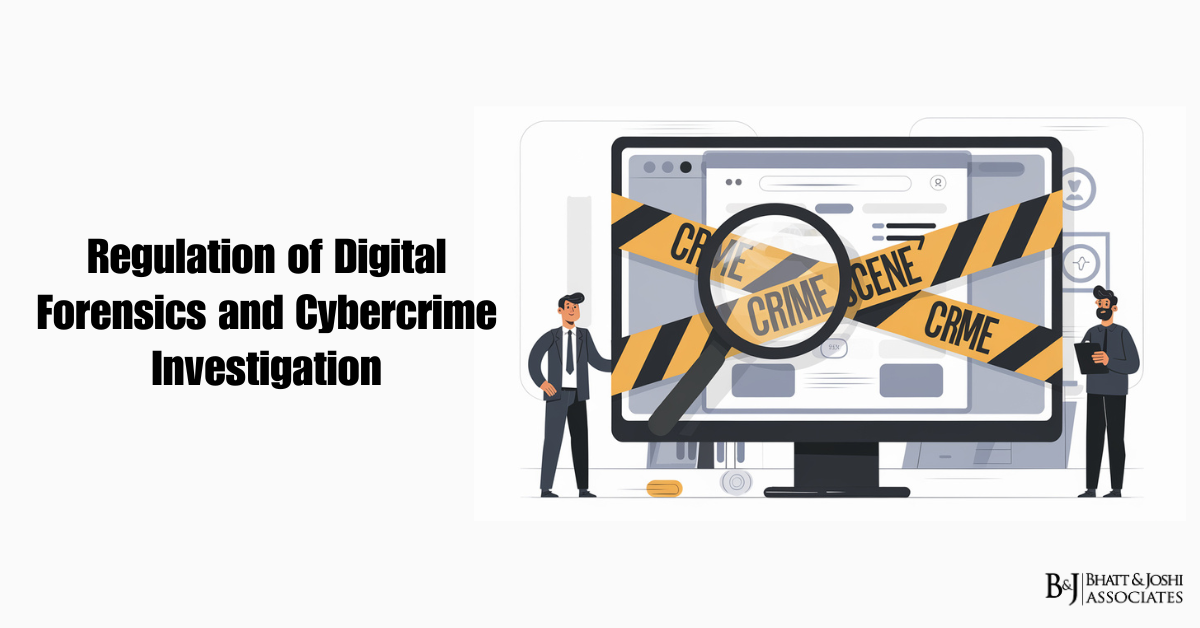Introduction
In an increasingly digital world, the rise in cybercrime has prompted significant developments in digital forensics and cybercrime investigation. These areas are critical in upholding justice, as cybercrime offenders often operate in ways that make traditional law enforcement mechanisms ineffective. Digital forensics involves retrieving and analyzing data from electronic devices to assist in the investigation of cybercrimes, while the regulatory frameworks ensure that this process adheres to legal standards and protects individual rights. This article provides a comprehensive exploration of how digital forensics and cybercrime investigations are regulated, with a focus on the relevant laws, case laws, and judicial precedents that define this complex field.
The Role of Digital Forensics in Cybercrime Investigation
Digital forensics is the branch of forensic science that focuses on the recovery, analysis, and presentation of electronic data, often in the context of criminal investigations. This field encompasses various aspects, including computer forensics, mobile forensics, and network forensics, all of which are crucial in today’s technological age where crimes are increasingly carried out over digital platforms.
The role of digital forensics in cybercrime investigation is critical. From identity theft, phishing, hacking, to more severe offenses like cyber terrorism and online fraud, digital forensics plays a central role in identifying offenders, reconstructing their actions, and preserving evidence that can be used in court. One of the core principles of digital forensics is the preservation of evidence integrity, meaning the data must not be altered during the forensic process. This is why digital evidence is often considered volatile, as any misstep in the handling of this evidence can lead to its inadmissibility in court.
Cybercrime, unlike traditional crime, often lacks a physical presence, making it harder to trace. As cybercriminals use increasingly sophisticated methods such as encryption, anonymous browsing, and even dark web platforms, law enforcement agencies face significant challenges in collecting, analyzing, and interpreting digital evidence. Therefore, the regulatory frameworks around digital forensics ensure that while investigators are equipped with the tools they need to pursue cybercriminals, they also respect the rights and liberties of individuals, particularly the right to privacy.
Key International and National Legislation Governing Cybercrime and Digital Forensics
Several laws have been enacted globally to regulate how digital forensics and cybercrime investigations are conducted. Internationally, the Budapest Convention on Cybercrime remains the first and most comprehensive international treaty designed to address internet and computer crime. Ratified by many countries, it outlines measures related to criminalizing offenses against and through computer systems, provides procedural tools for investigating such crimes, and fosters international cooperation among member states.
In India, the Information Technology Act, 2000 (IT Act) serves as the cornerstone for cybercrime law and digital forensics regulation. The IT Act criminalizes several cyber-related offenses such as hacking (Section 66), data theft (Section 43), and identity theft (Section 66C). It also provides provisions for the investigation of cyber offenses, granting law enforcement agencies the authority to intercept, monitor, and decrypt digital communications. The IT Act also facilitates the admissibility of electronic evidence in courts by amending the Indian Evidence Act, 1872, thereby establishing a legal foundation for digital forensics in India.
Section 65B of the Indian Evidence Act is particularly significant as it lays down the guidelines for the admissibility of electronic evidence in court. For any digital evidence to be admissible, it must be accompanied by a certificate under Section 65B, which verifies the accuracy of the electronic document. This section was reinforced in the landmark case Anvar P.V. v. P.K. Basheer (2014), in which the Supreme Court of India ruled that the absence of a Section 65B certificate would render the electronic evidence inadmissible. This ruling emphasizes the importance of strict procedural adherence in the collection and presentation of digital evidence.
In the United States, the Computer Fraud and Abuse Act (CFAA) criminalizes unauthorized access to computer systems, while the Electronic Communications Privacy Act (ECPA) governs the collection of electronic communications. Additionally, the Federal Rules of Evidence guide the admissibility of electronic evidence, ensuring that digital forensics in the U.S. aligns with constitutional protections.
Similarly, in the European Union, the General Data Protection Regulation (GDPR), the Directive on Attacks Against Information Systems (2013), and the Network and Information Security Directive (NIS Directive) are key legal instruments. The GDPR imposes strict restrictions on the collection and processing of personal data, including data obtained through digital forensics. The Directive on Attacks Against Information Systems establishes a framework for combating cybercrime across the EU, while the NIS Directive aims to enhance the security of networks and information systems within the EU member states.
Admissibility of Digital Evidence in Court
One of the most crucial aspects of digital forensics is ensuring that digital evidence is admissible in court. For evidence to be valid, it must be collected, preserved, and presented according to legal standards, ensuring its integrity throughout the investigative process. Courts worldwide have set clear guidelines on how digital evidence must be handled to be considered reliable and admissible.
In India, the Supreme Court has provided significant clarity on the issue of digital evidence through several judgments. In the Anvar P.V. case, as previously mentioned, the court mandated strict compliance with Section 65B of the Indian Evidence Act, thus ensuring that digital evidence cannot be admitted unless it is accompanied by a valid certificate. However, in the Shafhi Mohammad v. State of Himachal Pradesh (2018) case, the court somewhat relaxed this requirement, ruling that if a party cannot reasonably obtain a Section 65B certificate, it should not automatically result in the exclusion of electronic evidence. This provided some relief in instances where obtaining such a certificate would be impractical, such as in cases where the data is held by a third party or is otherwise inaccessible to the submitting party.
In the United States, the Federal Rules of Evidence establish the criteria for the admissibility of digital evidence. Rule 901 requires that evidence be authenticated, meaning that it must be proven to be what the proponent claims it to be. Additionally, Rule 403 ensures that the evidence is relevant and not overly prejudicial or misleading. These rules apply to digital evidence just as they do to any other form of evidence, ensuring that digital forensics adheres to strict standards of proof.
The U.S. Supreme Court, in the landmark case Riley v. California (2014), ruled that law enforcement agencies must obtain a warrant before searching the digital content of a smartphone. This decision highlighted the importance of protecting privacy in an age where personal devices store vast amounts of personal information. The court recognized that the search of a smartphone without a warrant would violate the Fourth Amendment’s protection against unreasonable searches and seizures.
In the European Union, the admissibility of digital evidence is guided by the European Convention on Human Rights (ECHR) and GDPR. Courts in the EU have ruled that while digital evidence is admissible, it must be collected in a manner that respects individual privacy rights under Article 8 of the ECHR. The European Court of Justice’s ruling in Digital Rights Ireland Ltd v. Minister for Communications (2014) invalidated the EU Data Retention Directive, holding that the mandatory retention of user data by telecom companies violated the right to privacy.
Challenges in Regulating Digital Forensics and Cybercrime Investigation
The regulation of digital forensics and cybercrime investigations faces numerous challenges, primarily due to the rapidly evolving nature of technology. One of the primary challenges is the issue of jurisdiction. Cybercrimes often transcend national borders, creating complications for law enforcement agencies tasked with investigating such crimes. Cooperation between countries is vital, but the lack of harmonized laws on cybercrime and digital forensics can hinder this process. The Budapest Convention on Cybercrime offers a framework for international collaboration, but it is not universally adopted, and many countries have yet to harmonize their laws with international standards.
Another significant challenge is the tension between law enforcement access to data and individual privacy rights. While law enforcement agencies require access to digital data to investigate cybercrimes, the right to privacy, enshrined in laws such as the GDPR and the ECPA, limits the extent to which this data can be accessed. Courts and legislators are constantly balancing these two competing interests. In some jurisdictions, governments have pushed for “backdoor” access to encrypted data, but privacy advocates argue that this would weaken overall security and lead to potential abuses.
Encryption poses another challenge for digital forensics. Cybercriminals often use encryption to protect their communications and hide evidence. While encryption is essential for securing personal information, it complicates law enforcement efforts to gather evidence. Governments in several countries, including the United States and the United Kingdom, have called for measures to weaken encryption for investigative purposes. However, this remains a contentious issue, with strong opposition from civil liberties groups and technology companies.
The fast-paced development of technology itself is another challenge. As new technologies emerge, such as blockchain, artificial intelligence, and quantum computing, cybercriminals are likely to find new ways to exploit these innovations. This will require law enforcement agencies and forensic experts to continuously update their methods and tools to stay ahead of criminals.
Recent Judicial Developments in Digital Forensics and Cybercrime
Recent court rulings have significantly shaped the regulatory landscape for digital forensics and cybercrime investigations. One of the most important cases in recent years is Carpenter v. United States (2018), where the U.S. Supreme Court ruled that law enforcement agencies must obtain a warrant before accessing historical cell phone location records. This case built upon the principles established in Riley v. California and further underscored the need for protecting privacy in the digital age.
In India, the Supreme Court ruling in the Shafhi Mohammad case, as previously discussed, offered greater flexibility in the admissibility of digital evidence, making it easier for parties to submit electronic records in cases where obtaining a certificate under Section 65B is difficult. This ruling reflects the judiciary’s acknowledgment of the practical challenges that arise in cases involving digital evidence, while still maintaining the overall integrity of the legal process.
In the European Union, the Schrems II decision by the Court of Justice of the European Union (2020) invalidated the EU-U.S. Privacy Shield, which allowed for the transfer of personal data between the EU and the U.S. The court ruled that the U.S. surveillance laws did not offer sufficient protection for EU citizens’ data, further emphasizing the importance of data privacy in the digital age.
The Future of Digital Forensics and Cybercrime Investigation
As technology continues to evolve, the future of digital forensics and cybercrime investigation will be shaped by emerging challenges and developments. Artificial intelligence and machine learning have the potential to transform forensic investigations by automating data analysis and pattern recognition. Blockchain technology, while primarily associated with cryptocurrencies, can also be used to create tamper-proof records, which could revolutionize how evidence is preserved and verified.
At the same time, the increasing use of quantum computing could render current encryption methods obsolete, potentially opening up new vulnerabilities for cybercriminals to exploit. Law enforcement agencies and legislators will need to stay ahead of these developments by updating legal frameworks and investing in advanced forensic tools.
In conclusion, the regulation of digital forensics and cybercrime investigations is a complex and rapidly evolving field. While technological advancements offer new opportunities for law enforcement, they also present new challenges that must be addressed through robust regulatory frameworks and international cooperation. Balancing the needs of law enforcement with the rights of individuals will remain a key concern as we move further into the digital age. Courts and legislatures must work together to ensure that justice can be achieved while safeguarding the fundamental rights of all individuals in the digital world.














